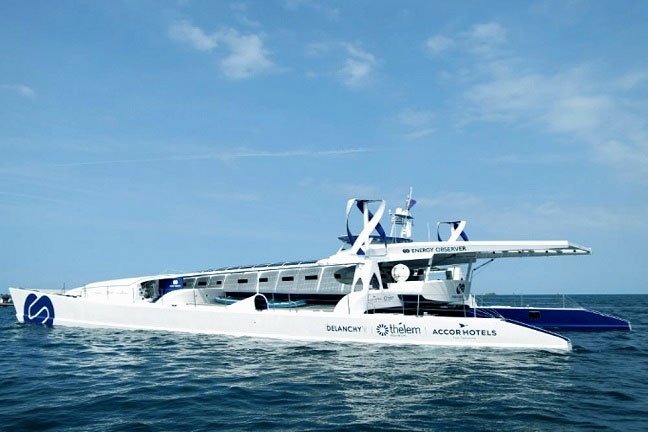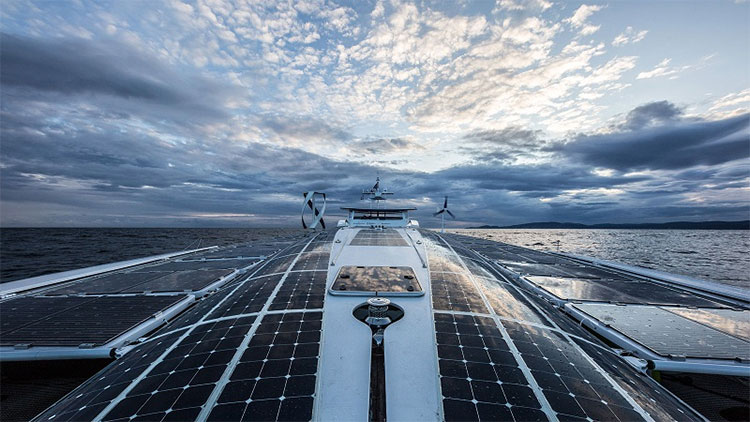Energy Observer - 'Laboratory' of floating energy throughout the world
Without using any fossil fuel source, the Energy Observer will be the most realistic test to demonstrate the effectiveness of clean energy.
After the first voyage in June 2017, to test the renewable energy source used for transportation, the Energy Observer experiment ship returned to Amsterdam to get a start page for a new journey. . Originally, the Energy Observer was a 30.5m long, 12.8m wide yacht, built in Canada in 1983.

The Energy Observer is on an experimental journey to find renewable and clean energy sources for marine vehicles.
Without using any fossil fuel source, the Energy Observer will be the most realistic test to demonstrate the effectiveness of clean energy, including solar, wind and hydrogen extracted from seawater. The technology equipped on the ship has been applied on land for a long time, but this is the first time they have been carried on a marine vehicle.
On this first trip, the Energy Observer traveled 10,000 nautical miles (about 18,500km) on the route from France to the Mediterranean. Due to being equipped with photovoltaic panels, during the journey, the ship used mainly solar energy, along with some hydrogen produced by electrolysis from seawater. Wind power was also put to the test, but because the two vertical axis wind turbines did not work as expected, so according to the Jérôme Delafosse experiment leader, this part of the wind energy has yet to be concluded.

The ship uses mainly solar energy.
Preparing for this second experimental voyage, the Energy Observer is supplemented with a total area of 168m 2 photovoltaic panels with a pair of new wings with a 12m wingspan named 'Oceanwings', ie' Ocean wings'.
The wings were designed by the naval architecture firm VPLP, inspired by the sailing sails of America's Cup of America. Only this is a hard wing like a helicopter wing but easier to use than a kite, fully automatic, capable of rotating 360 ° to help increase the speed of the train and reduce the force dynamics of motors, allowing the production of hydrogen right on the sea surface.
According to Jérôme Delafosse, the research leader, the Energy Observer will use hydrogen to power the propulsion through seawater desalination (removing salt and ions), then separating oxygen and hydrogen by electrolysis. Thereby, becoming the first ship capable of self-producing hydrogen.
Once the energy self-sufficiency goal is reached to cross the Atlantic and Pacific, completing a round-the-world tour in 2022, project proponents also hope that the technology can adapt with ships transporting goods, transporting passengers or cruise ships.
So these wings could be a true technological breakthrough in reducing energy costs for freight trains, according to the founder's claim and also captain of the Energy Observer, Victoria Erussard.

Energy Observer's goal is to show that boats of all types can operate thanks to renewable energy sources.
It is known that on a mass unit, hydrogen contains 3 times more energy than diesel and 2.5 times more than natural gas. In addition, its combustion process does not emit CO 2 or fine dust particles like fossil fuels. Energy Observer's goal is to show that boats of all types can operate thanks to renewable energy sources.
The Energy Observer left Saint-Malo on the morning of March 19, 2019 to prepare for a second-round world tour in the North Sea and Baltic regions to test new renewable energy technologies.
- 10 beautiful floating buildings in the world
- The world's first hydro-powered boat
- Coming soon the first floating city in the world
- China built the world's largest floating solar power plant
- Mining solar energy with coaxial nanowires
- World's first floating wind power generation station
- Floating buildings 'floating' of the future
- Video: The longest floating road in the world in China
- The hotel is quite energetic
- Future energy source from infrared rays
- China successfully tested fusion energy reactors
- The highest laboratory in the world
 Norway built the world's tallest wooden tower
Norway built the world's tallest wooden tower Kremlin
Kremlin Ashurbanipal: The oldest royal library in the world
Ashurbanipal: The oldest royal library in the world Decoding the thousand-year construction of Qin Shihuang shocked the world
Decoding the thousand-year construction of Qin Shihuang shocked the world